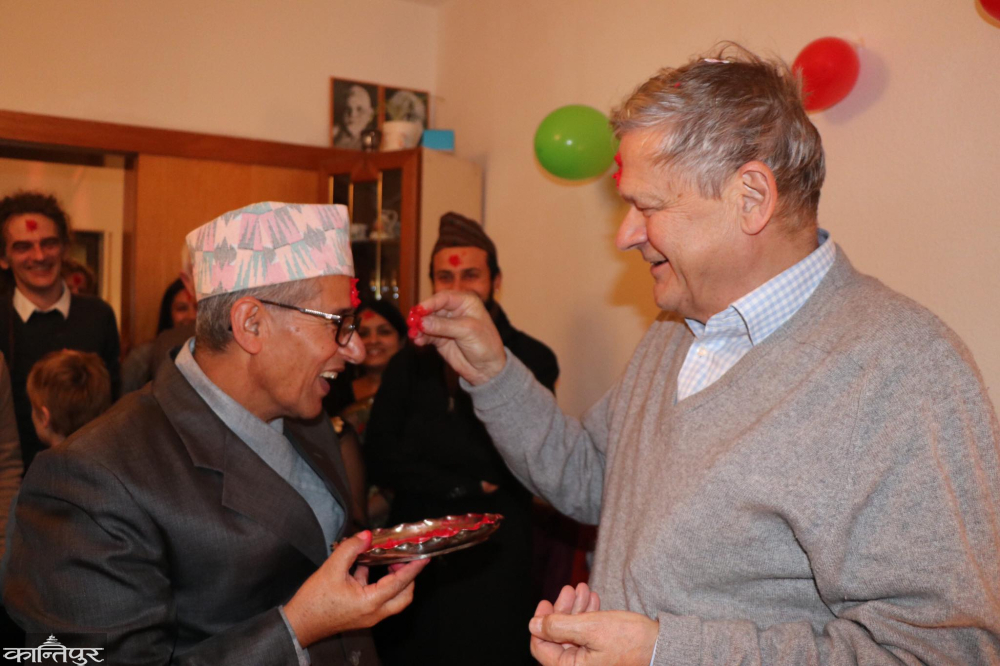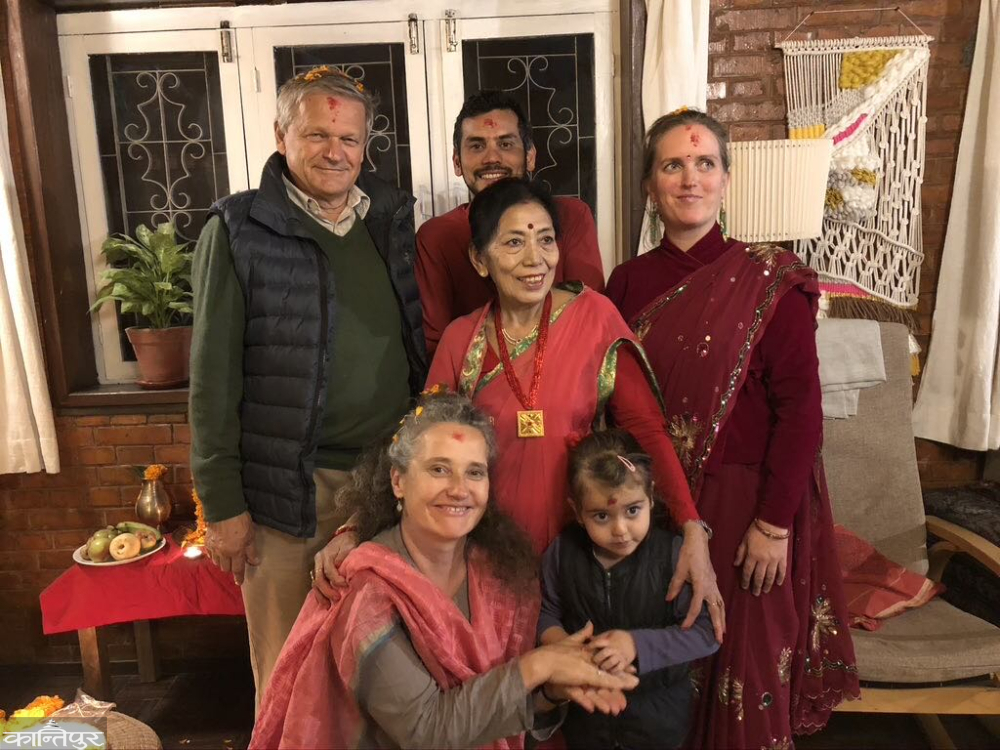"Culture is never a burden"
We use Google Cloud Translation Services. Google requires we provide the following disclaimer relating to use of this service:
This service may contain translations powered by Google. Google disclaims all warranties related to the translations, expressed or implied, including any warranties of accuracy, reliability, and any implied warranties of merchantability, fitness for a particular purpose, and noninfringement.


In 1971, the India-Pakistan war was at its peak. In the same year, Axel Michaels from Germany, who traveled to India in his own vehicle, was studying Sanskrit-language and Indian culture with Pandit Ambikadatta Upadhyay from Banaras. As the war intensified, he decided to sell his vehicle and return to Germany.



After it was not possible to sell vehicles in India, he came to Kathmandu via Raxaul. He didn't just sell vehicles, he returned to Germany with a deep love for Nepal.
After reaching Germany and graduating from Hamburg University in 1978 in 'Shulvasutra', his research examiner proposed to him, 'Do you want to go to Nepal under the Nepal-German Manuscript Conservation Project?' He immediately nodded his head in acknowledgment. "I never regret that decision that day," he says, remembering the professor's golden proposal.
Remembering that he used to go to a teacher to learn Nepali language after coming to Nepal, he said, 'At that time I was also learning Nepali with Laxminath Shrestha. I remember him. He used to teach Nepali very well. What was interesting about him was that from the day he started studying, he was not allowed to speak any language other than Nepali. As much as is known should be said in Nepali. After a few weeks, I started speaking normal Nepali. 3 weeks after I started studying, I gave my speech in Nepali language from the beginning to the end in a program. That was a proud moment for me.'
After coming to Nepal for the above mentioned project, Michael's life took a different turn. While studying about handwritten texts, he had already thought - now he should do something while staying in Nepal. If we do not study and preserve the historical, archeological and religious manuscripts in Nepal, they will be lost one day. While searching for
, his eagerness and passion to learn more about the old manuscripts of Nepal made him the director of the Nepal Research Center and the Nepal-German Manuscript Preservation Project. Under his leadership, he reached various places in Nepal and made microfilms of thousands of handwritten books and digitized them. While he was an assistant professor at the University of Kiel in Germany, he worked as the director of the Nepal Research Center. While working there, he remembers that he felt that the world should know Nepal's unique socio-cultural-religious and historical issues.

From 1983 to 1984, Michaels joined a project studying initiation traditions in Nepal in collaboration with the German Research Foundation. It gave him the opportunity to learn about the initiation rites of various natures of Nepal. His later days were mostly spent managing microfilms of old manuscripts and conducting various lectures for the Nepal Research Centre. "Though few authors have written, there are such topics in Nepal, which have not been fully written about and no one knows about such culture, customs, and lifestyles except the local community." He thinks that he should not be deprived of getting.
While working at the Nepal Research Center, Michaels and cultural expert Govind Tandon published a research book 'Pashupati Kshetra' after studying Pashupati Kshetra, which covers the environment and culture around Pashupatinath. He then taught Religious Studies at the University of Bern from 1992 to 1996.
 From 1996, he joined the South Asia Institute under the Heidelberg University, Germany's oldest university founded in 1386, as a professor of Classical Indology. From 1999 to 2002, he served as the director of the institute. At that time, the Institute of South Asian Studies of Heidelberg University used to be Nepalmay. The reason for this was - Michael's deep affection for Nepal studies and research. "When he was the director of this institute and the head of the department of Classical Indology, there was a program about Nepal continuously held in this institute," said Rajan Khatiwada, who studied the civil law of 1910 of Nepal from Heidelberg University.
From 1996, he joined the South Asia Institute under the Heidelberg University, Germany's oldest university founded in 1386, as a professor of Classical Indology. From 1999 to 2002, he served as the director of the institute. At that time, the Institute of South Asian Studies of Heidelberg University used to be Nepalmay. The reason for this was - Michael's deep affection for Nepal studies and research. "When he was the director of this institute and the head of the department of Classical Indology, there was a program about Nepal continuously held in this institute," said Rajan Khatiwada, who studied the civil law of 1910 of Nepal from Heidelberg University.
Michaels has published dozens of books and research articles on Nepal and edited dozens of research books. He says that it is important to study the language used at that time to uncover archeological and historical topics, and he says that among such languages Nepali, Sanskrit, and Nepali (Newari) are the main ones. "The study of Sanskrit and Nepal language is also indispensable because these languages have become the medium to learn not only about linguistics, Hinduism but also about Buddhism because its original texts are mainly written in these two languages," he says. Linguist and cultural expert Michaels expresses his concern that there are many such themes and important records in Nepal, but Nepal is not able to fully utilize and preserve them despite efforts to preserve them.
Two big projects are currently being conducted under his leadership, 'Historical Documentation of Premodern Nepal' and 'Nepal Archaeological Heritage Documentation Project' (NHDP). Historical Documents of Premodern Nepal works to make such historical documents in Nepal accessible to everyone through metadata. Through this project, images of historical documents created by the Nepalese-German Manuscript Cataloging Project are published as metadata on a digital platform. A series of books has been released in a series called Documenta Nepali. In that series, research books on Nepal are published by Heidelberg University under the Documenta Nepali series. So far, research books such as 'Studies in Historical Documents from Nepal and India', 'The Muluki Act of 1854', 'Slavery and Unfree Labor in Nepal', 'Drumming in Bhaktapur', 'Homicide Law in Nineteenth Century Nepal' have been published under this series. are.
Nepal Archaeological Manuscripts Project (NHDP) searches for the religious and cultural heritages in Nepal and gives all information about those heritages through the website of 'Nepal Heritage Documentation Project' and the application called 'Heritage Walk'. All these projects are conducted in direct collaboration with the Government of Nepal. The Historical Documents Project of Premodern Nepal is researching and publishing historical documents in coordination with the Nepal National Archives of the Government of Nepal. The Nepal Archaeological Manuscript Project (NHDP) is working on heritage conservation in coordination with the Kathmandu Valley Preservation Trust, Department of Archeology of the Government of Nepal. Michaels says, 'Our goal is that these kinds of scientific research should directly add Nepal to the world history study and research map. Generally speaking, Indology in Western universities is only associated with India. However, my purpose is that Nepal has a special place in the study and research of Indology, no one could colonize Nepal directly, so Nepal continued to advance with original identity in terms of social, religious, economic and political practices than other colonized countries in South Asia and around. For example, without the involvement of any colonial power, the coming of a larger legal document that gives a glimpse of the constitution like the Civil Act in 1854 and clearly shows Nepal in the 18th-19th century and being used as a law is a unique example of the legal history of South Asia. Despite this, the civil law can be viewed from different perspectives. Although it was a specific legal document of that time, due to the implementation of the caste structure through legal documents by the Civil Act, the caste system took root in Nepal, which despite various efforts of the government and society, it seems that it has not been able to be eradicated. However, in terms of research, legal documents of the 19th century can be analyzed as historical documents. In the legal history of South Asia, the introduction of the Civil Code six years earlier than British India's Penalcoat shows the legal consciousness of the rulers of Nepal at that time.'' Time to the Present', 'The Making of a Statue: Last-Wax Casting in Nepal', 'Hinduism: Past and Present',

'Handling Death', 'Homo Rituals', 'Getting Married', 'Shiva in Trouble', 'Growing Up: Hindu and Buddhist Initiation Rituals Among Newar Children in Bhaktapur', 'The Price of Purity'. He does not care about how many times I have visited Nepal since 1971, nor does he care about how many academic articles he has written about Nepal. Heidelberg University has given him the title of Senior Professor in recognition of his academic quality and contribution, including his research on conservation of Nepal's cultural heritage, conservation and digitization of historical manuscripts. He has received dozens of honors such as Germany's prestigious Lautenschlager Research Award.
At that time, Nepal was chosen as the field of study and research because of its hospitality and the custom of looking at people's caste and background much less than in India. Even those who came from foreign countries were considered 'Mlechcha'. It was considered impure. However, in Nepal, it was comparatively less than that. As my study and research topic is especially about festivals, traditions and rituals, I would have developed more relationship with the Newars, so I didn't have to be accused of being so much 'Tan Mlechcha'.'' Nepal's unity within its diversity is attractive. Diverse religions, sects, different lifestyles are important topics for Nepal. The history of Nepal is even more interesting. The original culture and tradition have enhanced the beauty here. Another unique and important beauty is the unity of Hindus and Buddhists. Such a unique fusion is rarely seen in the world. There are many such topics, which have not been properly studied and researched. "One life is not enough to know all these topics, let's say Nepal," he says.
He says that even though it is said from time to time that the original customs and culture are being lost while learning the western culture in Nepal day by day, this is not entirely true. The situation is definitely different now than it was then. But, I don't think traditions, cultures are disappearing that much. Now numerically many tourists observe such festivals, Jatras, modernity has also come. The main thing is that those festivals are still being celebrated. Such festivals are not films shown in a theater, these are matters connected with the roots of the tribals there,' he said, 'therefore, leaving aside some things that have changed compared to before, it seems that the festivals and customs celebrated at that time are still alive. It does not seem that the festival itself is destroyed. Perhaps one or two common Jatras are probably not celebrated now – like the Ganga Mai Jatra. However, some Jatras are celebrated with more energy than before. These are also linked to subject identity. That's why it should be protected.'
Due to the influence of western culture, some traditions and cultures are being modified and some traditions are disappearing. Is it better for such cultures-traditions to change with time or to disappear or let's say to develop with time? He says, 'Nepali should keep things like cultural heritage, traditions, festivals, Guthi-Boj alive. Culture should never be taken as a burden .'
 प्रकाशित : जेष्ठ ५, २०८१ ११:२२
प्रकाशित : जेष्ठ ५, २०८१ ११:२२

 २१.१२°C काठमाडौं
२१.१२°C काठमाडौं
















